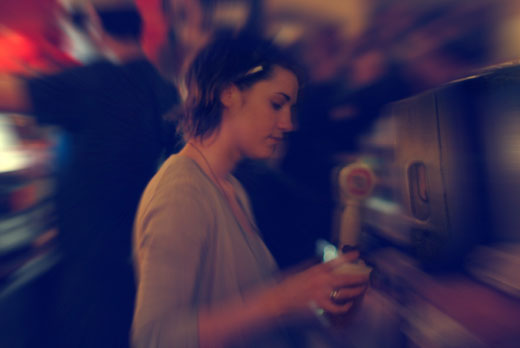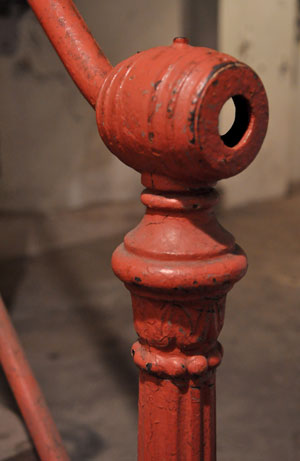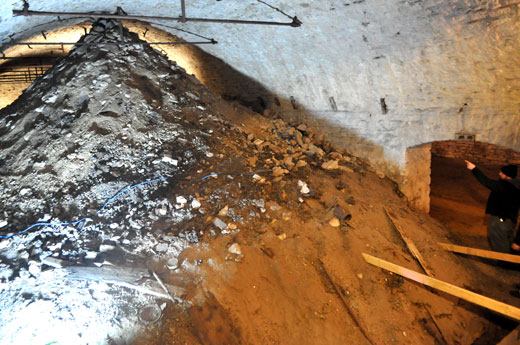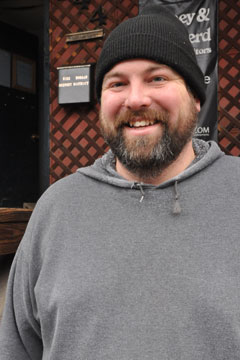Soapdish: Bocktoberfest!
Soapdish columnist Casey Coston gets his bock on this week in anticipation of Over-the-Rhine’s long running tradition celebrating the coming of spring and tapping of the first Bock beer. Coston examines the history of a festival that’s not just about consuming beer for beer’s sake but also celebrates architecture and a way of life that’s not too far removed from the one urban dwellers are seeking all over the country and a cultural experience that most people can only find on a trip to Europe.
 Attention loyal Cincinistas – while the weather may seem, shall we say, less than “tropical,” a cure for your seasonally affected malady is just around the corner.
Attention loyal Cincinistas – while the weather may seem, shall we say, less than “tropical,” a cure for your seasonally affected malady is just around the corner.
Pay no attention to those gun-metal grey skies and that frozen unforgiving tundra looming just outside your door. These are the times when young (and young at heart) men and womens’ thoughts turn to…well…beer. That’s right, beer glorious beer; and not just any beer – Bock Beer! Indeed, ’tis time once again for Cincinnati’s annual Bockfest celebration.
 For the uninitiated, Cincinnati in the 1800’s was one of America’s most prolific brewing cities. Riding the wave of a strong influx of German immigrants, Cincinnatians drank more beer per capita than any city in the country. Per capita consumption of beer in America in 1893 averaged sixteen gallons – folks in our fair city quaffed a mere forty – and Over the Rhine, with a German American population hovering around 60-70%, was the epicenter of this sudsy, hop-induced extravaganza. Vine Street, from Central Parkway to McMillan, had at least fifty saloons. So many, in fact, that it even cowed 1901-era/temperance crusader Carrie Nation into submission, as she reportedly dropped her window-smashing axe in the face of the sheer spectacle of it all, noting that “I would have dropped from exhaustion before I had gone a block.”
For the uninitiated, Cincinnati in the 1800’s was one of America’s most prolific brewing cities. Riding the wave of a strong influx of German immigrants, Cincinnatians drank more beer per capita than any city in the country. Per capita consumption of beer in America in 1893 averaged sixteen gallons – folks in our fair city quaffed a mere forty – and Over the Rhine, with a German American population hovering around 60-70%, was the epicenter of this sudsy, hop-induced extravaganza. Vine Street, from Central Parkway to McMillan, had at least fifty saloons. So many, in fact, that it even cowed 1901-era/temperance crusader Carrie Nation into submission, as she reportedly dropped her window-smashing axe in the face of the sheer spectacle of it all, noting that “I would have dropped from exhaustion before I had gone a block.”
Yet I digress. “Bock” (“goat” in German) finds its link to beer in an old Renaissance-era tale of a drinking contest between two German beer-brewing monks. In a yee olde world twist on your standard game of quarters, the beer’s potency was said to have caused the loser of this duel to effectuate a face plant on the abbey’s unforgiving stone floor, which he sheepishly blamed on a wayward goat. The victor, gloating, replied that the only goat knocking him down was in the beer, and, thus, the bock beer legend was born.
Just like their Belgian cousins working the Trappist magic, the German monks fired up their home breweries and stockpiled the bock as Spring drew closer. During the Lenten fast, the potent bock beers provided heftier sustenance and nutrients than the lighter lagers, thus providing a convenient liquid lunch (not to mention breakfast and dinner) for fasting (and no doubt hard partying) monks. Over-the-Rhine, during its beer barrel heyday, was home to approximately thirty-eight breweries (eighteen of which are still around in some form or another). In a nod to the change of season, a tradition developed among the breweries to release all of their bock beer on the same day, in the process marking the end of the Winter brewing season and the beginning of Spring.
 The current Bockfest tradition was resurrected eighteen or so years ago, as residents and supporters of Over-the-Rhine unearthed and promoted one of the city’s great old traditions. It has since evolved into an all-out Bohemian brewhaha, replete with a “Sausage Queen” and a bizarre parade spectacle featuring a Trojan goat.
The current Bockfest tradition was resurrected eighteen or so years ago, as residents and supporters of Over-the-Rhine unearthed and promoted one of the city’s great old traditions. It has since evolved into an all-out Bohemian brewhaha, replete with a “Sausage Queen” and a bizarre parade spectacle featuring a Trojan goat.
This year’s event will be spotlighting a number of watering holes in and around OTR (plus Arnold’s), including the recently announced Jack Potts Tavern – opening later this Spring in the old Jefferson Hall space on Main. In addition, Bockfest Hall itself will be located just off of Vine (behind the Guildhaus) in what was originally part of the old Kauffman Brewery complex and, more recently, housed Husman’s Potato Chips. While rumors have recently been swirling regarding “big things” for this old brewery, formal announcements have yet to be made. As such, patrons will have to be content for a brief three day renaissance of the site for the time being.
The sold-out Prohibition Resistance Tour is further evidence, both literally and figuratively, of how Bockfest has unearthed the relics and tradition of Cincinnati of yore. The tour focuses on some of the remaining breweries in Over the Rhine, particularly those on “Brewer’s Boulevard” (i.e. McMicken), with a spotlight on the subterranean lagering cellars and tunnels. Some tunnels extend far away from the structure (in one such example, to a building across McMicken), and have not been open to the public for at least fifty years. These are the catacombs of Cincinnati, and we were fortunate enough to have Steve Hampton, architect and President of the Brewery District CURC, give us a sneak peak. The maze of chambers, tunnels and immense vaults beneath the city is a sight to behold. Combined with Hampton’s vast knowledge of the sites and structures, I always had the vague feeling I was in a riveting, real-life History Channel special. Spelunking in Over-the-Rhine’s “Beer-acombs” has simply GOT to be Cincinnati’s tourist attraction of the future. It’s that cool.
 Although the Prohibition Resistance Tour is sold out (over 600 tickets sold for the weekend tours), tickets are still available for Sunday’s tour of historic churches and beer halls (not as incongruous as the two may sound). The tour, coordinated by the Over the Rhine Foundation, includes visits to St. Frances Seraph (circa 1851) and its underground crypt (the site was a Catholic cemetery immediately prior to St. Frances’ construction), Nast Trinity (1842) on Washington Park, as well as Old St. Mary’s, Cincinnati’s oldest church dating back to 1841.
Although the Prohibition Resistance Tour is sold out (over 600 tickets sold for the weekend tours), tickets are still available for Sunday’s tour of historic churches and beer halls (not as incongruous as the two may sound). The tour, coordinated by the Over the Rhine Foundation, includes visits to St. Frances Seraph (circa 1851) and its underground crypt (the site was a Catholic cemetery immediately prior to St. Frances’ construction), Nast Trinity (1842) on Washington Park, as well as Old St. Mary’s, Cincinnati’s oldest church dating back to 1841.
For those that have never been inside these historic churches, the tour is a real eye opener. It’s always odd how, when the average American tourist stomps around Europe, whether fiercely agnostic or dutifully devout, one of the first places they hit are the churches. Interestingly enough, however, many of the oft-overlooked historic churches on this tour contain features and architectural details, including murals, intricate woodwork, statuary and stained glass, that rival much of what you will find in Europe. Sure, it’s not going to rival the mega-cathedrals of Europe (e.g. Cologne, Milan, Notre Dame etc.), but the tour really gives you a sense of what it was like to live in Over-the-Rhine in the mid-nineteenth century. In contrast to the skyscrapers of downtown, Over-the-Rhine always maintained its distinct old world feel, with buildings no higher than five stories, and many rising just two. As a result, the omnipresent church spires seemingly peak above the rooftops at every angle.
 Sunday’s tour Sunday’
Sunday’s tour Sunday’
Sunday’s Church tour replicates an olde world Sunday experience in more respects than one – the tour also includes rare stops inside both the stunning Cosmopolitan Hall and a rare visit inside Wielert’s Beer Garden both being potential barhopping stops for 19th Century churchgoers following services.
Interestingly enough, Over-the-Rhine in its heyday was a rare neighborhood in Cincinnati where the consumption of alcohol was widespread, even encouraged, on Sundays. These so-called “Continental Sundays” did not sit well with many of the more pious non-OTR residents. As OTR Foundation head Mike Morgan notes: “Historically, it was a big bone of contention in the city that the Germans would drink on Sunday.”
 Indeed, tensions often ran high between the fun loving, beer swilling, predominantly German American dwellers of Over-the-Rhine and those in the city at large. In one such historical example, in 1855, a nativist mob attempted to invade Over-the-Rhine, only to be met by the gunfire of the well-armed and highly organized German American militia units and rifle clubs. For two days, five hundred Germans manned a barricade across Vine Street. Fortunately, the gun-toting Germans held off the siege in a victory for those who would, apparently, fight for their right to party. Organizers ensure me that participants on this Sunday’s tour will encounter no such nativist mobs, so feel free to leave the rifles and muskets at home. The tour concludes at Bockfest Hall for German Cultural Day, where Continental Sunday fun continues with various activities, entertainment and, of course, plenty of bock beer.
Indeed, tensions often ran high between the fun loving, beer swilling, predominantly German American dwellers of Over-the-Rhine and those in the city at large. In one such historical example, in 1855, a nativist mob attempted to invade Over-the-Rhine, only to be met by the gunfire of the well-armed and highly organized German American militia units and rifle clubs. For two days, five hundred Germans manned a barricade across Vine Street. Fortunately, the gun-toting Germans held off the siege in a victory for those who would, apparently, fight for their right to party. Organizers ensure me that participants on this Sunday’s tour will encounter no such nativist mobs, so feel free to leave the rifles and muskets at home. The tour concludes at Bockfest Hall for German Cultural Day, where Continental Sunday fun continues with various activities, entertainment and, of course, plenty of bock beer.
So break out the dirndls and lederhosen folks, as Over-the-Rhine is going to party like it’s 1899. For more information on all of the myriad activities, visit the Bockfest website.
Photography by Scott Beseler
Kristen Page of Grammer’s stretching for Bock Fest
Keg hand rail
Prohibitionist tour below OTR
A hundred years worth of debris below the surface
Old St. Mary’s
Mike Morgan













